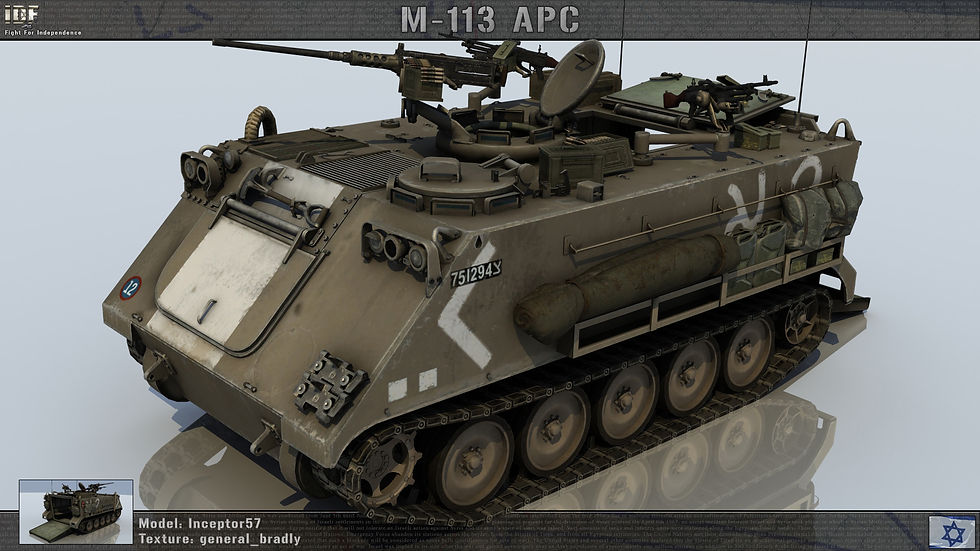IDF : Fight For Independence

The Panhard AML-90 is a fast, long-ranged, and relatively cheap first-generation armoured car with excellent reconnaissance capability. The AML-90 was fitted with a low velocity DEFA D921 90mm smoothbore cannon. Israeli AML-90s fought in the Six Day War and the War of attrition before being withdrawn from service. They were able to knock out more than a dozen Egyptian and Jordanian tanks but also suffered very high losses in the process due to thier light armor.

The M3 Half-track is a armored personnel carrier, which was widely used by the IDF to preform multiple roles.

The TCM-20 was an Israeli development of the American 50 caliber M45 mount. It was equipped with two 20mm Hispano-Suiza cannons. The TCM-20 was developed after the Six day war to provide more firepower to frontline units. It was successfully used to fire at and suppress enemy tank hunting teams as well its intended role as an anti-aircraft gun.

The M-113, an APC with aluminum armor that was designed to be thick enough to protect against small arms, but light enough to enable air transport. To date over 80,000 M-113s have been produced and used by over 50 countries, making it one of the most popular APCs ever. The IDF began receiving M-113s in the late 1960s to eventually replace the aging M3 half-tracks.

The AMX-13 is a French light tank, produced from 1953 to 1985, By 1967 Israel had acquired about 400 AMX-13s, and three AMX-13 battalions fought actively on all fronts.

The Sho't Kal Alef is an Israeli modification based on the Centurion tank. The powerpack was upgraded to the Continental AVDS-1790-2A diesel engine and the Allison CD850-6 transmission. The upgraded powerpack improved the tank's speed, range of travel and because it was a diesel engine, reduced the chances of ignition in the engine. The gun was upgraded wo the Royal Ordnance L7 105mm gun.

The 'Magach'-3 was a development by the IDF to bring the IDF's 'Magach's to the level of the M48A3. The gun was upgraded to the Royal Ordnance L7 105mm gun. The Commander cupola, which was considered a nuisance among Israeli tank crews, was replaced with a low-profile Israeli turret without the M2 12.7mm. The engine was replaced with a 750 hp diesel engine, which provided a range of 465 kilometers and was less flammable.

The 'Magach'-6 was the IDF name given to the M60 and M60A1. The main difference in the M60A1 compared to the M60 is the longer turret that allows storage of more shells available to the loader (21 vs. 8 lying shells).

The M-109 155 mm is an American-made turreted self-propelled howitzer which introduced in early 1960, it able to launch a projectile out to 8.8 miles (~14km away). The armored hull protects its crew and firing system from enemy fire as well as bad weather. Mounted with M2 50cal to provide close protection in case of need. The version presented here, which is the first operational version, can be identified by its short barrel and the large fume extractor.

The M107 175 mm self-propelled gun was intended to provide long-range fire support in an air-transportable system. The M107 was able to launch a 147 lb (67 kg) projectile out to 21 miles (~35km away). During the Yom Kippur War it was one of the few weapons able to destroy Egyptian and Syrian anti-aircraft missile positions. Of the 15 SA-2 batteries lost by Egypt on the east bank of the Suez Canal, 13 were destroyed by M107s. M107s also had sufficient range to hit the Syrian capital of Damascus.

The M-110 203 mm is an American-made self-propelled howitzer, nicknamed "Cardom" (Hatchet) by the IDF. The M-110 was able to launch a standard projectile out to 15.5 miles (~25km away), it was the largest self-propelled cannon in the United States military arsenal. During the Yom Kippur War, when the IDF was running out of 175 mm ammunition, M-107 units were converted to the M-110.

The M-548, nicknamed "Alfa" by the IDF, a tracked ammunition cargo carrier, based on the M-113. The M-548 has 360 degrees rotating turret mounted with M2 50cal to provide close protection in case of need.

The M35 2½-ton cargo truck is a long-lived 2½-ton 6x6 cargo truck initially used by the United States Army and subsequently utilized by many nations around the world. The M35 started as a 1949 REO Motor Car Company, The basic M35 cargo truck is rated to carry 5,000 pounds (2,300 kg) off-road or 10,000 pounds (4,500 kg) on roads. Trucks in this weight class are considered medium duty by the military and the Department of Transportation.

The M35 2½-ton cargo truck is a long-lived 2½-ton 6x6 cargo truck initially used by the United States Army and subsequently utilized by many nations around the world. The M35 started as a 1949 REO Motor Car Company, The basic M35 cargo truck is rated to carry 5,000 pounds (2,300 kg) off-road or 10,000 pounds (4,500 kg) on roads. Trucks in this weight class are considered medium duty by the military and the Department of Transportation.

The M35 2½-ton cargo truck is a long-lived 2½-ton 6x6 cargo truck initially used by the United States Army and subsequently utilized by many nations around the world. The M35 started as a 1949 REO Motor Car Company, The basic M35 cargo truck is rated to carry 5,000 pounds (2,300 kg) off-road or 10,000 pounds (4,500 kg) on roads. Trucks in this weight class are considered medium duty by the military and the Department of Transportation.